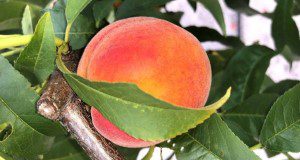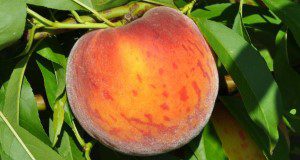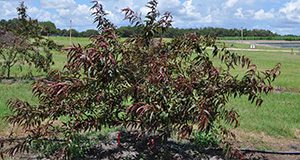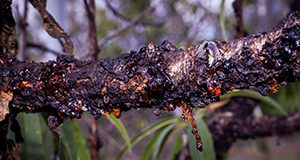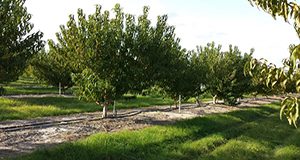El suave clima invernal de Florida y el comienzo de la temprano de primavera ofrecen oportunidades únicas para la producción de duraznos y nectarinas de temporada temprana. Durante los últimos 12 años, la Universidad de Florida ha lanzado muchos cultivares nuevos de durazno y nectarina. Estos nuevos y mejorados cultivares han aumentado el potencial de expansión del aspecto comercial de melocotones y nectarinas en gran parte de la península de Florida y en las regiones de la Costa del Golfo del sureste de los Estados Unidos.
This new 5-page article is the Spanish translation of RFAC018, Alternative Opportunities for Small Farms: Peach and Nectarine Production Review. Written by Ali Sarkhosh, Mercy Olmstead, Jeff Williamson, Jose Chaparro, and Juanita Popenoe, translated by Eva Pabon, and published by the UF/IFAS Horticultural Sciences Department.
https://edis.ifas.ufl.edu/hs1374
Tag: Mercy Olmstead
Variedades de Durazno y Nectarina en la Florida
La Universidad de la Florida ha desarrollado cultivares de nectarina y durazno de alta calidad, bajo requerimiento de horas frio, y de maduracion temprana que pueden cultivarse desde el Panhandle de la Florida (noroeste del estado) tan al sur como Immokalee. Cultivares de bajas horas frio pueden crecer y producir fruta bajo las condiciones de la Florida que son mucho mas calidas en el invierno que en estados mas al norte. This 18-page fact sheet, translated by Tatiana Sanchez and published by the UF/IFAS Horticultural Sciences Department, is the Spanish-language version of CIR1159, Florida Peach and Nectarine Varieties, written by Ali Sarkhosh, Mercy Olmstead, Jose Chaparro, Pete Andersen, and Jeff Williamson.
https://edis.ifas.ufl.edu/hs1346
Blueberry Frost Protection Practices in Florida and Georgia

Written by Tatiana Borisova, Elizabeth Conlan, Erick Smith, Mercy Olmstead, and Jeffrey Williamson and published by the UF/IFAS Food and Resource Economics Department, this publication was developed to assist professionals attempting to establish a benchmark for when to use frost protection in blueberry production. This benchmark can assist in developing outreach strategies to educate producers about frost protection strategies, and it can also help measure changes in their frost protection behavior over time.
http://edis.ifas.ufl.edu/fe1045
Rootstocks for Florida Stone Fruit
Rootstocks are used in many tree fruit systems to provide growth advantages and/or pest and disease resistance without affecting (sometimes improving) productivity and fruit quality. This 6-page document discusses the use of rootstocks for Florida stone fruit. Written by Ali Sarkhosh, Mercy Olmstead, Jose Chaparro, and Thomas Beckman and published by the UF/IFAS Horticultural Sciences Department, November 2018.
http://edis.ifas.ufl.edu/hs366
Peach Rust (Transchelia spp.)
Peach rust is a fungal disease that attacks plants like peach, nectarine, almond, plum, apricot, and cherry. Infections can be particularly severe in warm weather with high rainfall, so Florida summers provide favorable conditions for peach rust development. This 6-page document describes the characteristics and management of peach rust. Written by Daniel Mancero-Castillo, Ali Sarkhosh, Courtney Ligon, Mercy Olmstead, and Philip Harmon and published by the UF/IFAS Horticultural Sciences Department, July 2018.
https://edis.ifas.ufl.edu/hs1263
Fungal Gummosis in Peach
Peach fungal gummosis (PFG) is a vascular disease that limits the growth and yield of peach orchards in the southeastern United States. This 6-page document discusses the symptoms and management of PFG. Written by Daniel Mancero-Castillo, Ali Sarkhosh, Sara Sherman, Mercy Olmstead, Philip Harmon, and Thomas Beckham and published by the UF/IFAS Horticultural Sciences Department, July 2018.
https://edis.ifas.ufl.edu/hs1265
Irrigation Practices for Peaches in Florida
This 6-page document provides basic information and guidelines on water requirements and irrigation strategies for peaches grown in Florida. Written by C. Zambrano-Vaca, L. Zotarelli, K. Migliaccio, R. Beeson Jr., K. Morgan, J. Chaparro, and M. Olmstead and published by the UF/IFAS Horticultural Sciences Department, April 2018.
http://edis.ifas.ufl.edu/hs1316
Establishment and Production Costs for Peach Orchards in Florida: Enterprise Budget and Profitability Analysis
While the Florida peach industry is small, it has experienced significant growth in recent years. This 20-page article written by Ariel Singerman, Marina Burani-Arouca, and Mercy Olmstead and published by the Food and Resource Economics Department summarizes the establishment and production costs as well as the potential profitability of a peach orchard in Florida. It includes an enterprise budget, estimates of potential revenue and undiscounted cash flows for different combinations of prices and yields, and an investment analysis. The information in this article should be relevant to both current and potential Florida peach growers.
http://edis.ifas.ufl.edu/fe1016
Frost Protection Irrigation for Florida Peaches: Economic Considerations
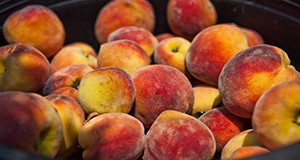
Peach production in Florida is increasing in importance, and the peach industry is growing rapidly in the state, where the early harvest and early market window allow the prices for Florida peaches to be high compared to those received by producers in the other southeastern states. Reduction in peach production costs would allow Florida peach producers to increase their net revenues. This 7-page fact sheet describes a strategy for limiting water use for frost protection of peach trees in the winter to reduce producers’ costs, protect lakes and streams, and reinforce the public image of farmers as innovators and environmental stewards. Written by Tori Bradley, Tatiana Borisova, and Mercy Olmstead and published by the Food and Resource Economics Department.
edis.ifas.ufl.edu/fe980
Growing Plums in Florida
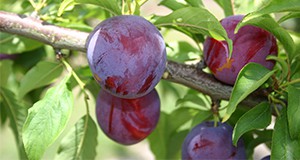
Plums could be a potential crop for growers and homeowners in Florida and other mild winter areas throughout the Gulf coast, but many plum varieties will not grow well enough in Florida to produce fruit. In response to this need, the University of Florida has developed cultivars that improve the potential for growing plums in Florida. This twelve-page fact sheet provides information for growing plums in Florida including information about chilling hours, pollination and fruit set, fruit harvesting, yields, as well as information about the plum cultivars adapted to grow in Florida. Written by M. Olmstead, E.P. Miller, P.C. Andersen, and J.G. Williamson, and published by the Horticultural Sciences Department.
http://edis.ifas.ufl.edu/hs250
Improving the Precision of Blueberry Frost Protection Irrigation
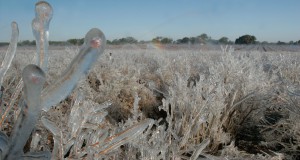
In Florida, early-ripening southern highbush blueberry cultivars allow growers to take advantage of high prices in the early market before other states can compete with higher volumes of berries sold at lower prices. That advantage comes with a vulnerability, however, because frosts can reduce gains. Florida growers rely on strategies like cold protection irrigation to reduce their risk of loss due to cold damage. This 9-page article by Tatiana Borisova, Tori Bradley, Mercy Olmstead, and Jeffrey Williamson describes a UF/IFAS study comparing precision cold protection irrigation to uniform cold protection irrigation to estimate the potential savings in diesel costs and water withdrawal volumes associated with the two practices and help protect Florida’s valuable and vulnerable blueberry harvest. Published by the Food and Resource Economics Department in November 2015.
http://edis.ifas.ufl.edu/fe979
Peach Rust
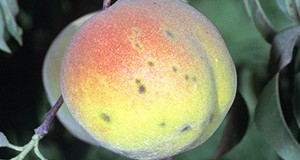
Peach rust is a fungal disease that affect the leaves and, less commonly, twigs and fruit of peach trees. The fungus that causes peach rust thrives in Florida’s humid climate and may cause significant economic losses in severely affected orchards. This 5-page fact sheet details peach rust symptoms, disease cycle, and management, including fungicide treatments. Written by Courtney Ligon, Mercy Olmstead, and Phillip Harmon, and published by the UF Department of Horticultural Sciences, June 2015.
http://edis.ifas.ufl.edu/hs1263
Fungal Gummosis in Peach
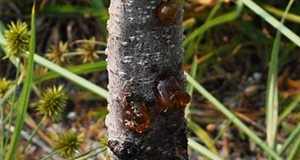
Fungal gummosis in peach occurs when the fungus Botryosphaeria dothidea infects small openings or wounds in tree branches or trunks. The disease causes blisters on the tree that form lesions and eventually ooze gum (sap). This 3-page fact sheet covers the disease cycle and management of fungal gummosis in peach, which is often difficult to control. Written by Sara Sherman, Mercy Olmstead, Philip Harmon, and Thomas Beckman, and published by the UF Department of Horticultural Sciences, July 2015.
http://edis.ifas.ufl.edu/hs1265
Peach Scab
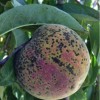 Peach scab is a disease caused by the fungus Cladosporium carpophilum. The pathogen can infect other fruits and nuts within the Prunus species, like almonds, apricots, nectarines, and plums. Peach scab is common during periods of humid weather because rain splashes the conidia (asexual spores) from the fungus between leaves, twigs, and fruit in the tree canopy, which spreads the disease. This 6-page fact sheet was written by Daniel Mancero-Castillo, Mercy Olmstead, and Phillip Harmon, and published by the UF Department of Horticultural Sciences, July 2014.
Peach scab is a disease caused by the fungus Cladosporium carpophilum. The pathogen can infect other fruits and nuts within the Prunus species, like almonds, apricots, nectarines, and plums. Peach scab is common during periods of humid weather because rain splashes the conidia (asexual spores) from the fungus between leaves, twigs, and fruit in the tree canopy, which spreads the disease. This 6-page fact sheet was written by Daniel Mancero-Castillo, Mercy Olmstead, and Phillip Harmon, and published by the UF Department of Horticultural Sciences, July 2014.
http://edis.ifas.ufl.edu/hs1249
Florida Subtropical Peaches: Production Practices
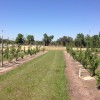 Subtropical peach production includes many practices, such as site selection, orchard design, and disease, weed, and insect management through to harvest. Florida’s subtropical climate allows growers to harvest their crops early, but it creates challenges for the long postharvest growing season. This 14-page fact sheet covers the breadth of topics related to subtropical peach production, including a monthly timeline of recommended practices. Written by M. Olmstead, J. Chaparro, J. G. Williamson, R. Rouse, R. Mizell, P. Harmon, and J. Ferguson, and published by the UF Department of Horticultural Sciences, August 2013.
Subtropical peach production includes many practices, such as site selection, orchard design, and disease, weed, and insect management through to harvest. Florida’s subtropical climate allows growers to harvest their crops early, but it creates challenges for the long postharvest growing season. This 14-page fact sheet covers the breadth of topics related to subtropical peach production, including a monthly timeline of recommended practices. Written by M. Olmstead, J. Chaparro, J. G. Williamson, R. Rouse, R. Mizell, P. Harmon, and J. Ferguson, and published by the UF Department of Horticultural Sciences, August 2013.
http://edis.ifas.ufl.edu/hs348
Orchard Establishment Budget for Peaches and Nectarines in Florida
 Stone fruit production in Florida, specifically peaches (Prunus persica L.), has increased in acreage since the mid-2000s, predominantly driven by the desire to diversify agricultural operations. Although the National Agriculture Statistics Service does not keep annual production and acreage statistics for peaches because of the industry’s small size, a recent poll revealed just over 670 acres in Florida, with about 700 unreported acres (Table 1) (Morgan and Olmstead 2013). Statewide, current estimates of harvested peaches are approximately 4.5 million pounds, with a value of more than $6 million. Florida growers can take advantage of an early market window in which they produce the first domestic peach of the calendar year, commanding a high price per pound. The future of peach production in the state is very positive, and many growers continue to plant new orchards. This 12-page fact sheet was written by Mercy Olmstead and Kim Morgan, and published by the UF Department of Horticultural Sciences, July 2013.
Stone fruit production in Florida, specifically peaches (Prunus persica L.), has increased in acreage since the mid-2000s, predominantly driven by the desire to diversify agricultural operations. Although the National Agriculture Statistics Service does not keep annual production and acreage statistics for peaches because of the industry’s small size, a recent poll revealed just over 670 acres in Florida, with about 700 unreported acres (Table 1) (Morgan and Olmstead 2013). Statewide, current estimates of harvested peaches are approximately 4.5 million pounds, with a value of more than $6 million. Florida growers can take advantage of an early market window in which they produce the first domestic peach of the calendar year, commanding a high price per pound. The future of peach production in the state is very positive, and many growers continue to plant new orchards. This 12-page fact sheet was written by Mercy Olmstead and Kim Morgan, and published by the UF Department of Horticultural Sciences, July 2013.
http://edis.ifas.ufl.edu/hs1223
Florida Peach and Nectarine Varieties
 The University of Florida has developed high-quality, low-chilling, early-maturing peach and nectarine cultivars that can be grown from the panhandle of Florida to as far south as Immokalee. Low-chilling cultivars can grow and produce fruit under Florida conditions that are much warmer in winter than in northern states. Furthermore, ripening of these cultivars during April and May ensures an early spring market window for tree-ripe fresh fruit in Florida before peaches and nectarines from other southeastern states and California come to market. Both commercial and dooryard recommended varieties span the growing season. This 8-page fact sheet was written by Mercy Olmstead, Jose Chaparro, Pete Andersen, Jeff Williamson, and James Ferguson, and published by the UF Department of Horticultural Sciences, May 2013.
The University of Florida has developed high-quality, low-chilling, early-maturing peach and nectarine cultivars that can be grown from the panhandle of Florida to as far south as Immokalee. Low-chilling cultivars can grow and produce fruit under Florida conditions that are much warmer in winter than in northern states. Furthermore, ripening of these cultivars during April and May ensures an early spring market window for tree-ripe fresh fruit in Florida before peaches and nectarines from other southeastern states and California come to market. Both commercial and dooryard recommended varieties span the growing season. This 8-page fact sheet was written by Mercy Olmstead, Jose Chaparro, Pete Andersen, Jeff Williamson, and James Ferguson, and published by the UF Department of Horticultural Sciences, May 2013.
http://edis.ifas.ufl.edu/mg374
Rootstocks for Florida Stone Fruit (HS1110/HS366)
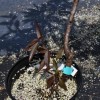 Rootstocks have been used in many tree fruit systems to provide growth advantages or pest or disease resistance without affecting productivity and fruit quality. In Florida, stone fruit are grown on rootstocks that specifically provide pest resistance to the peach root-knot nematode. Although several root-knot nematode-resistant rootstocks are available for stone fruit grown in other locations and climates, ‘Flordaguard’ peach rootstock is currently recommended for stone fruit production in Florida. This 5-page fact sheet was written by M. Olmstead, J. Chaparro, and J. Ferguson, and published by the UF Department of Horticultural Sciences, November 2012.
Rootstocks have been used in many tree fruit systems to provide growth advantages or pest or disease resistance without affecting productivity and fruit quality. In Florida, stone fruit are grown on rootstocks that specifically provide pest resistance to the peach root-knot nematode. Although several root-knot nematode-resistant rootstocks are available for stone fruit grown in other locations and climates, ‘Flordaguard’ peach rootstock is currently recommended for stone fruit production in Florida. This 5-page fact sheet was written by M. Olmstead, J. Chaparro, and J. Ferguson, and published by the UF Department of Horticultural Sciences, November 2012.
http://edis.ifas.ufl.edu/hs366
Alternative Opportunities for Small Farms: Peach and Nectarine Production Review (RFAC018/AC018)
 Florida produces some of the earliest commercial-quality peaches and nectarines in North America. During the last 10 years, many new, improved peach and nectarine cultivars have been released by the University of Florida. They have increased the potential for expansion of commercial peach and nectarine acreage throughout much of the Florida peninsula and along the Gulf Coast regions of the southeastern United States. This 3-page fact sheet was written by Mercy Olmstead, Jeff Williamson, Jose Chaparro, and Tim Crocker, and published by the UF Department of Horticultural Sciences, September 2011.
Florida produces some of the earliest commercial-quality peaches and nectarines in North America. During the last 10 years, many new, improved peach and nectarine cultivars have been released by the University of Florida. They have increased the potential for expansion of commercial peach and nectarine acreage throughout much of the Florida peninsula and along the Gulf Coast regions of the southeastern United States. This 3-page fact sheet was written by Mercy Olmstead, Jeff Williamson, Jose Chaparro, and Tim Crocker, and published by the UF Department of Horticultural Sciences, September 2011.
http://edis.ifas.ufl.edu/ac018
